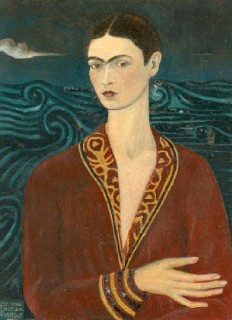Self
Portrait in a
Velvet Dress
1926
This is Frida's first self-portrait. It was painted as a gift for her student boyfriend, Alejandro Gomez Arias, who had left her. It was given as a token of love by which she hoped to restore his affection and keep her in his thoughts. Her plea for his love worked and, not long after Alejandro received the portrait, they were rejoined.
The aristocratic pose reflects Frida's interest in the paintings of the Italian Renaissance period. This self-portrait is Frida's interpretation of Botticelli's "Venus" which Alejandro admired. The same style would later appear in her "Portrait of Alicia Galant", 1927, and "Portrait of Adriana", 1927.
Frida began this self-portrait in the summer of 1926 and sent it to Alejandro in late September. On the back of the painting she inscribed a dedication: "For Alex. Frida Kahlo, at the age of 17, September 1926 - Coyoacan -Heute ist Immer Noch" (Today still goes on).
In March of 1927, Alejandro's parents sent him on a tour of Europe with his uncle…mainly to separate him from Frida, of whom they did not approve. Before leaving, he returned the painting to Frida for safe keeping.
This self-portrait was one of four paintings that Frida took to show Diego Rivera and ask his opinion of her work. After viewing the paintings, Rivera remarked that he was most interested in this self-portrait "...because it is the most original" he said.

Oil on canvas
31" x 23 ½"
Private Collection
Bequest of Alejandro Arias
Mexico City
Óleo sobre lienzo
79,7 x 60
cm.
Colección
privada
Legado de Alejandro Arias
Ciudad de México
Autorretrato
con
traje de terciopelo
1926
Este es el primer autorretrato de Frida. Lo pintó como regalo para su compañero de estudios y novio, Alejandro Gómez Arias, quien había roto la relación. Se lo dió como prueba de amor con la cual esperaba recuperar su afecto y que él la mantuviera en sus pensamientos. Su ruego de amor funcionó y poco tiempo después de que Alejandro recibiera el retrato, se reconciliaron.
La pose aristocrática refleja el interés de Frida en las pinturas del período Renacentista italiano. Este autorretrato es la interpretación de Frida de la "Venus" de Boticelli, obra admirada por Alejandro. El mismo estilo aparecería en su "Retrato de Alicia Galant", 1927 y "Retrato de Adriana", 1927.
Frida empezó este autorretrato en el verano del 1926 y lo envió a Alejandro a finales de Septiembre. En la parte trasera de la pintura escribió en alemán : "Hoy es siempre todavía" , un aparente reflejo de su estado de ánimo después de su separación.
En marzo de 1927, los padres de Alejandro lo enviaron a Europa con su tío, principalmente para separarlo de Frida, de la cual no aprobaban. Antes de irse, Alejandro le devolvió la pintura a Frida para que la guardara a salvo.
Este autorretrato fue una de cuatro pinturas que Frida tomó para mostrar Diego para pedirle su opinión sobre su trabajo. Después de ver las pinturas, Rivera dijo que estaba muy interesado en este autorretrato "...porque es el más original", dijo.